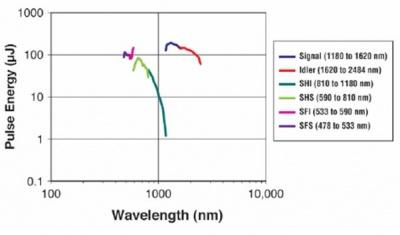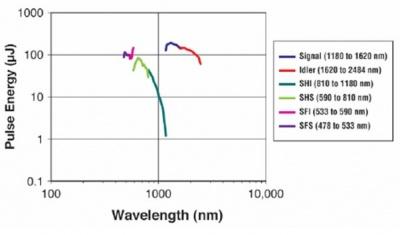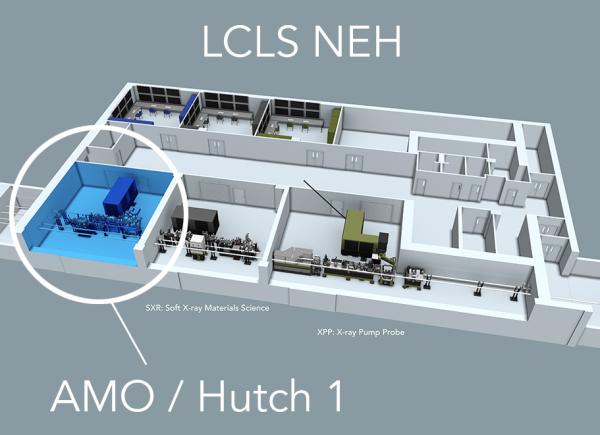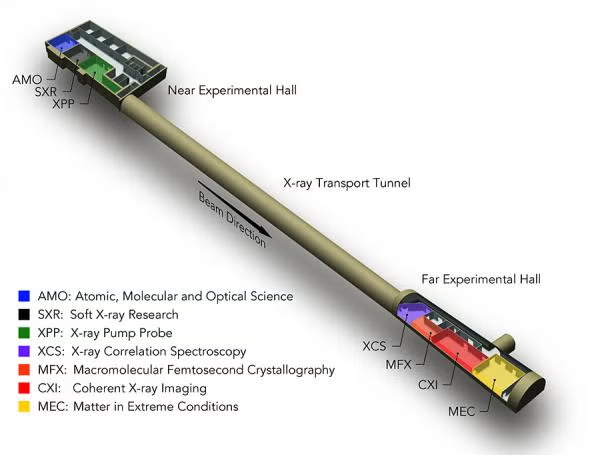AMO Standard Configurations
AMO Standard Configuration #1 for Run 17
#1 Imaging
Types of Experiments
With this new standard configuration, AMO will be able to support various time-resolved X-ray and/or IR pump X-ray probe imaging experiments examining ultrafast dynamics in an array of gaseous and cluster based targets
X-ray and X-ray Focus
X-ray energies ranging from 450 to 2000 eV will be available. Soft X-ray self-seeding (SXRSS), variable polarization control (DELTA), and ns separated FEL pulses will not be allowed.
AMO’s KB focusing system can provide foci up to ~2 micron (FWHM) and is adjustable in size up to several 10s of microns FWHM.
Optical Pump Lasers
Time-resolved experiments employing tunable femtosecond pulses will be supported under this standard configuration. The fundamental and second harmonic (800 nm and 400 nm) of the AMO, ~50 fs Ti:Sapphire laser will be available, delivered to the sample collinearly with the x-rays, with in-coupling ~350 mm upstream of the sample and with the focusing lens ~1000-1500 mm away from the sample.
The configuration can also be used with a TOPAS-Prime Optical Parametric Amplifier (OPA) capable of 1300-2400 nm wavelengths. Only signal or idler wavelengths will be offered, no visible output from the OPA is allowed. Note that the efficiency of the optics and the performance of the laser and the OPA will not be the same for the entire offered wavelength range. The achievable peak intensity/fluence will be determined by the existing optical system and will not be modified. Contact the AMO scientists to discuss specific needs and to confirm whether they can be achieved in this standard configuration of the laser.
The expected performance of the OPA is shown below (signal & idler curves only).

Timing Diagnostics
The AMO transmission sample system Time-Tool (TT) will be available to record single shot arrival times (t<50fs) that can be post-sorted. A jitter-corrected plot can be shown online during the experiment provided the X-ray is not too attenuated. Coarse temporal overlap (t<20 ps) can be obtained via fast x-ray and optical diode (on the focus paddle).). Retrievable time-tool signals when using weaker FEL pulses from special FEL modes (SXRSS, two-color, etc) is known to be difficult.
Sample Delivery
The standard gas delivery setup will be a double skimmer stage with differential pumping. A pulsed Parker (Iota One) valve, mounted from the top of the LAMP chamber, will be offered as part of the standard configuration. For detailed information, please contact AMO scientists.
Detectors
The LAMP endstation will be outfitted with one large-area (78 x 74 mm2) 1 Megapixel pnCCD detector (75 x 75 um2 pixel size) sensor plane, capable of counting single scattered or fluorescent photons with high quantum efficiency (>90%) with an energy resolution of 40 to 200 eV between <450 eV and 2.0 keV. A variable-sized hole in the center of the front CCD allows the direct FEL and optical beams to pass through.
LAMP will also be outfitted with an LCLS owned MCP based, ion time-of-flight situated orthogonal to the X-ray scattering plane in the interaction region for detecting photo-ions from the event.
AMO Instrument Staff
Peter Walter, Stefan Moeller, James Cryan, Giacomo Coslovich, and Michael P. Minitti
Parameter Table
To be considered for scheduling in this standard configuration, users will be required to include a table in the proposal that lists the specific experimental parameters to ensure compatibility with these configurations. If the experimental parameters are not compatible with the standard configuration or if the table of parameters is incomplete, the proposal will be reviewed and considered for scheduling as general user proposal. Please see the table of required parameters. No fundamental changes to the standard configurations will occur, but some details of the configuration may be updated in response to inquiries, so users should check the website before submitting your proposal to confirm that you have the latest information. Address any questions to the instrument staff.
AMO Standard Configuration #2 for Run 17
#2 Spectroscopy
Types of Experiments
With this new standard configuration, AMO will be able to support various time-resolved X-ray and/or IR pump X-ray probe spectroscopy experiments examining the ultrafast molecular dynamics in gas phase.
X-ray and X-ray Focus
X-ray energies ranging from 350 to 2000 eV will be available. Soft X-ray self-seeding (SXRSS), two-color FEL, and two-pulse operations will be offered as part of the standard configuration.
AMO’s KB focusing system can provide focus down to 2 micron (FWHM) and is adjustable in size up to several 100s of microns FWHM.
Optical Pump Laser
Time-resolved experiments employing tunable femtosecond pulses will be supported under this standard configuration. The fundamental and second harmonic (800 nm and 400 nm) of the AMO, ~50 fs Ti:Sapphire laser will be available, delivered to the sample collinearly with the x-rays, with in-coupling ~350 mm upstream of the sample and with the focusing lens ~1000-1500 mm away from the sample.
The configuration can also be used with a TOPAS-Prime Optical Parametric Amplifier (OPA) capable of 1300-2400 nm wavelengths. Only signal or idler wavelengths will be offered, no visible output from the OPA is allowed. Note that the efficiency of the optics and the performance of the laser and the OPA will not be the same for the entire offered wavelength range. The achievable peak intensity/fluence will be determined by the existing optical system and will not be modified. Contact the AMO scientists to discuss specific needs and to confirm whether they can be achieved in this standard configuration of the laser.
The expected performance of the OPA is shown below (signal & idler curves only).

Timing Diagnostics
The AMO transmission sample system Time-Tool (TT) will be available to record single shot arrival times (t<50fs) that can be post-sorted. A jitter-corrected plot can be shown online during the experiment provided the X-ray is not too attenuated. Coarse temporal overlap (t<20 ps) can be obtained via fast x-ray and optical diode (on the focus paddle).). Retrievable time-tool signals when using weaker FEL pulses from special FEL modes (SXRSS, two-color, etc) is known to be difficult.
Sample Delivery
The standard gas delivery setup will be a double skimmer stage with differential pumping. A pulsed Even-Lavie (E-L) valve, mounted from the top of the LAMP chamber, will be offered as part of the standard configuration. For detailed information, please contact AMO scientists.
Detectors
The standard configuration for atomic/molecular spectroscopy will feature a high resolution hemispherical analyzer (Sienta EW 4000) installed in the LAMP interaction region. The spectrometer features a 60° angular acceptance range and an energy window of 10% of the pass energy. The spectrum is read out via a 2D 40mm MCP/CCD detector system.
The standard configuration also features a short flight tube ion time of flight spectrometer. Downstream of the LAMP chamber we will offer a unique velocity map imaging spectrometer for high energy electron spectroscopy. This VMI operates in a coaxial geometry (i.e. the x-rays propagate along the spectrometer flight axis). We have demonstrated spectroscopy with moderate energy electrons (~50-100 eV) with ~0.5-1% resolution. There is also the possibility to collect electrons with higher kinetic energies (up to several hundred eV).
AMO Instrument Staff
Peter Walter, Stefan Moeller, James Cryan, Giacomo Coslovich, Ryan Coffee, and Michael P. Minitti
Parameter Table
To be considered for scheduling in this standard configuration, users will be required to include a table in the proposal that lists the specific experimental parameters to ensure compatibility with these configurations. If the experimental parameters are not compatible with the standard configuration or if the table of parameters is incomplete, the proposal will be reviewed and considered for scheduling as general user proposal. Please see the table of required parameters. No fundamental changes to the standard configurations will occur, but some details of the configuration may be updated in response to inquiries, so users should check the website before submitting your proposal to confirm that you have the latest information. Address any questions to the instrument staff.
AMO CONTACT INFO
Peter Walter
SXD Instrument Scientist
(650) 926-3997
pwalter@slac.stanford.edu
Stefan Moeller
SXD Instrument Scientist
(650) 926-5321
smoeller@slac.stanford.edu
AMO Control Room
AMO LOCATION


